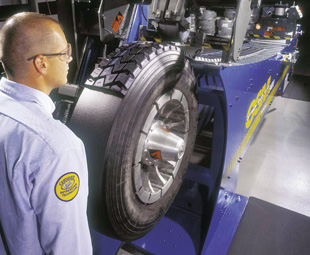Retreading is recycling

Retreading of tyres is a common practice in the trucking industry worldwide. What are the benefits and how do consumers know that they are fitting a quality product? GAVIN MYERS finds out from Monal Naik, marketing manager of Bandag South Africa.
South Africa has a waste-tyre problem. The Retail Motor Industry (RMI) Organisation claims that approximately ten million tyres are sold in South Africa each year – all of which will eventually become waste. By its very nature, retreading commercial-vehicle tyres conforms to the “reduce, reuse, recycle” principle of waste minimisation; thus helping in a small way to reduce the waste-tyre problem.
“For every casing that is retreaded, one less new tyre is used and one less tyre is added to the growing scrap heap. Beginning with a premium new tyre could yield more than one retread life, and so the above benefit is multiplied. In this way, fleet operators are able to amortise their investment in new tyres over multiple lives – the environmental and financial benefits are significant enough to invest in a proper retreading policy,” Naik explains.
Retreading a premium casing, he adds, has shown to be more beneficial in the long run than replacing the tyre with a cheaper, imported alternative. “Our data shows that, while the initial cost saving of cheap new tyres might look attractive, the long-term outlook is quite the opposite. Since retreads cost a fraction of a new tyre, investing in a premium new tyre that could deliver multiple retread lives is a sure way to optimise a cost-per-kilometre benefit,” Naik says.
Whether retreaded or new, tyres are an investment that needs to be looked after. It’s for this reason that not any old tyre can be retreaded.
Before a tyre is retreaded, the casing is inspected according to strict qualifying criteria. Naik says that Bandag technicians will reject a casing if it has severe bead damage or multiple repairs that overlap. Tyres that have become fatigued do not get retreaded. Furthermore, he explains, Bandag technicians use an ECI Machine to detect any missed nail holes.
“Any casing needing major repairs, those with chemical contamination, run flats and those that have been re-belted are not retreaded through the Bandag process. Safety is a non-negotiable factor in the Bandag end product,” Naik reiterates.
Casings that qualify for retreading are prepared for the application of a new tread and then cured in a chamber. “Bandag uses a lower curing temperature than most other retreaders to maintain the integrity of the casing,” Naik says. Final inspection is part of the quality-control process and every retreaded tyre goes through this process.
Companies, such as Bandag, conduct regular audits on its franchisees that conform to its global manufacturing standards. “These audits look into all aspects of the Bandag retreading process including the manufacturing, environmental and quality aspects,” Naik explains. Bandag also adheres to ISO standards in its own manufacturing facility.
“Fleets need to benchmark and make informed decisions on the right product for their specific needs,” Naik explains. There’s no doubt that using retreaded tyres can meet many needs – including reduced costs and lowering the environmental impact of waste tyres and the carbon footprint of fleets.
Published by
Focus on Transport
focusmagsa




